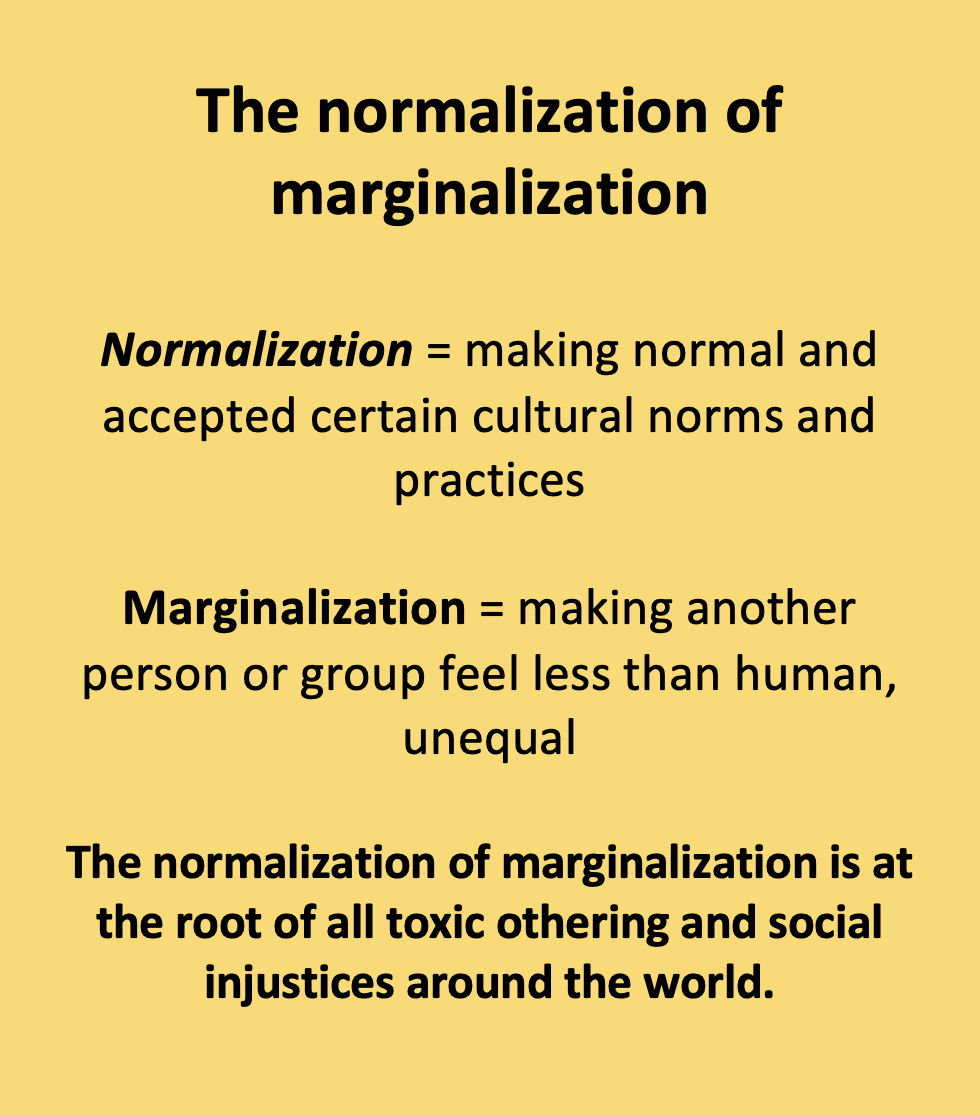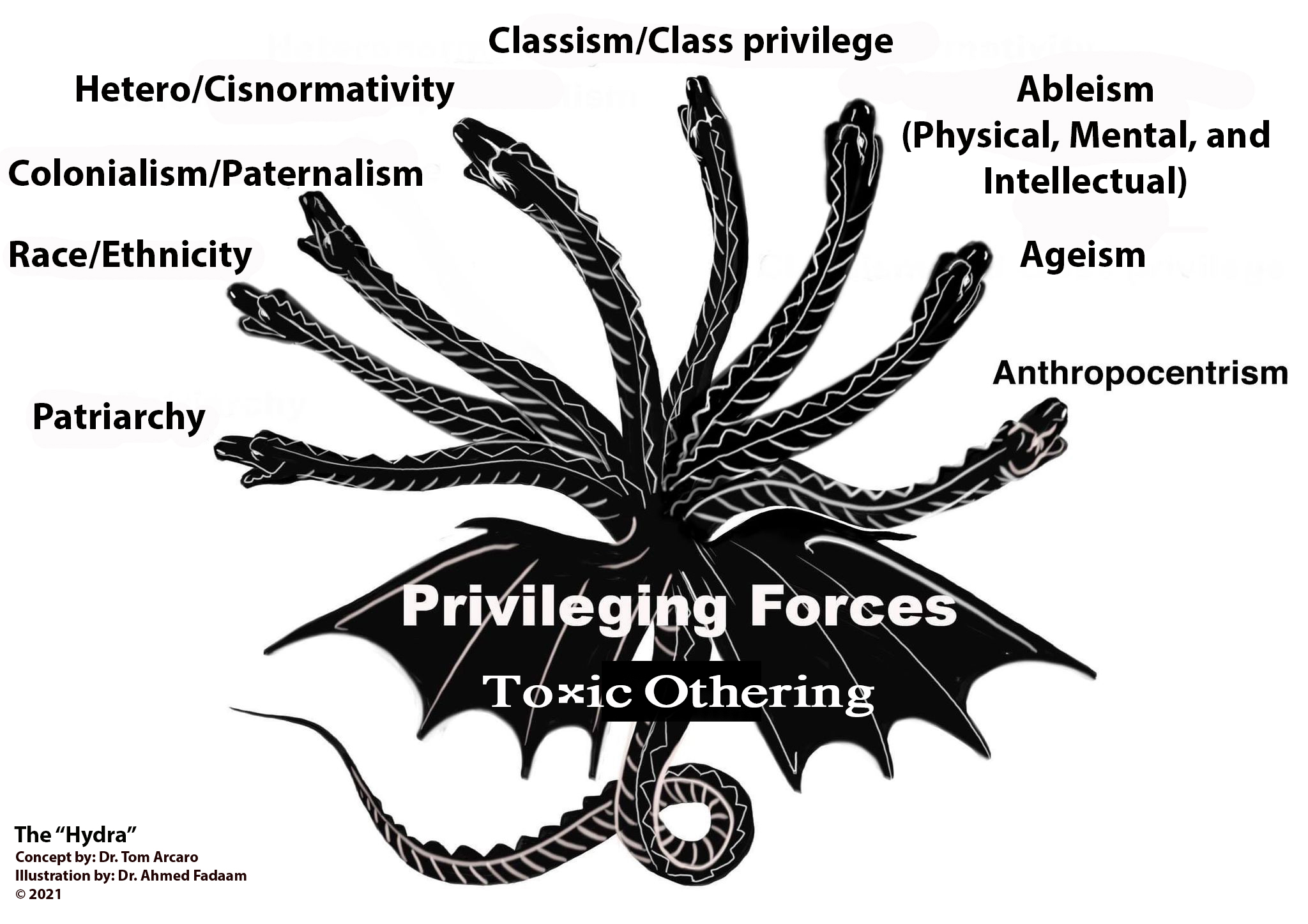[Updated 8-7-23]
Confronting toxic othering exercise
‘…the inherent dignity and of the equal and inalienable rights of all members of the human family is the foundation of freedom, justice and peace in the world…
-from the first sentence of the Preamble to the Universal Declaration of Human Rights
[Note: This exercise is an example of how to employ critical Hydra theory (CHT). For additional context the reader is invited to explore various other posts on this blog.]
Overview
This exercise builds on the insights and methodologies of Critical Race Theory (CRT). The purpose of this exercise is to generate examples of how toxic othering has been confronted at all levels, local, national, and global. One of the most important wisdom‘s from CRT is that we must interrogate the history of racism and how racist ideologies have been entrenched into laws, policies, norms, and general expectations of behavior. In CRT there is a specific emphasis on examining systemic and legally buttressed racism, partly represented by what sociologists have long called ‘institutional racism.’
 CHT looks at all ways in which the normalization of marginalization has infected cultural systems. The ‘normalization of marginalization’ is synonymous with the process of toxic othering. This exercise is intended to raise awareness as to how this normalization has taken place and to celebrate the process of calling out and denormalizing marginalization.
CHT looks at all ways in which the normalization of marginalization has infected cultural systems. The ‘normalization of marginalization’ is synonymous with the process of toxic othering. This exercise is intended to raise awareness as to how this normalization has taken place and to celebrate the process of calling out and denormalizing marginalization.
In the application of critical Hydra theory (CHT) we use exactly the same logic paying attention to all the other privileging forces; all heads of the Hydra are the products of toxic othering where those in power have normalized and in many instances formalized the marginalization of those groups being othered. This exercise employs the methodologies and insights of critical race theory to apply to all of the remaining privileging forces.
One intended outcome of this exercise is that those participating will be energized discovering and detailing progress made. One critical question is whether the gains represented by new or changed laws and policies made relative to one privileging force be used to explore similar changes relative to other privileging forces. In any case, a deep awareness of how these forces have been woven into the fabric of the culture is very important.
Step one: Examples of confronting toxic othering
The social injustices created by all of the privileging forces rarely just appear ‘out of thin air’; they are typically the product of many incremental actions ranging from simple micro aggressions to sweeping policies and laws. The fight against manifestations of toxic othering is similarly incremental and is often represented by small victories.
With the goal of being as thorough as possible, research how each privileging force has been confronted both recently and in the past at all three levels, namely local, national, and global. Populate the table below (or a table of your own construction) with examples, giving as many as you can find. Make sure to include both major, headline making changes and those which may seem more modest. Find examples of changes in norms, policies, or laws which have helped ‘confront toxic othering’ in each of the privileging forces. This exercise has several goals including
- to provide the student/learner with an opportunity to hone their research skills;
- to raise the awareness of there many positive actions that are taking place;
- to create a database of examples which may inspire others to act.
Pedagogical note: This exercise works well breaking the class down into teams assigned to just one of the privileging forces.
| Privileging forces | Recent-local | Past-local | Recent-national | Past-national | Recent-global | Past-global |
| Patriarchy | ||||||
| Race/Ethnicity | ||||||
| Colonialism/paternalism | ||||||
| Hetero/cisnormativity | ||||||
| Classism | ||||||
| Ableism | ||||||
| Ageism | ||||||
| Anthropocentrism |
Below is an example using patriarchy. See here for more examples from my students.
Patriarchy
Local recent: Gov. Cooper Executive Order 93 attacking gender wage gap (2019)
Local past: Isabella Cannon became first female mayor of a major NC city (Raleigh) in 1977
National recent: 2017 Women’s March in Wasington, DC broke record for largest one-day protest for women’s rights in US history
National past: First women’s rights convention- Seneca Falls, NY, 1848
Global recent: Women were granted the right to drive a vehicle in Saudi Arabia in July 2018
Global past: Convention on the Elimination of all Forms of Discrimination against Women held in 1979
This exercise clearly demands a good deal of time and seems ready-made for group work. The overall idea would need to be discussed and clarified and teams formed to tackle, for example, one privileging force.
An alternate approach
Another approach to organizing the grid, for example in the case of humanitarian workers, an alternate grid could include personal, organization, and sector wide actions and changes made both past and presernt.
| Privileging forces | Personal, past and present | Organizationally, past and present | Sector-wide, past and present |
| Patriarchy | |||
| Race/ethnicity | |||
| Colonialism/paternalism | |||
| Hetero/cisnormativity | |||
| Classism | |||
| Ableism | |||
| Ageism | |||
| Anthropocentrism |
Step two: More questions
Below is a suggestive list of questions to explore after a good number of examples have been generated. Each of these questions can easily turn into a long discussion; that indeed is the intent. Focusing on one head of the Hydra at a time may seem limiting but it may be more useful to go one by one before making attempts at outlining the many connections between these privileging forces.
- What person, group, or organization was behind the efforts making possible the examples you researched? What forms of social action were employed?
- What push back was there from those in power against the various examples? What form did this push back come in and was violence ever used as a weapon?
- Were there ‘champions’ or leaders that emerged during the struggle to implement the change? If so, how did they lead and motivate others?
- What trends or patterns can you see that explains the success of these changes?
- What was the time frame in which these changes happened and what factors most impacted the rate of progress?
- For which privileging force was it most difficult to generate examples? Why do you think this is so?
- For which privileging force was it easiest to generate examples? Why do you think this is so?
- To what extent did you find that some examples bridged more than one privileging force? Give examples of these instances.
- To what extent did you find that the policy or law change addressing one privileging force led to interest in pushing for change against another privileging force?
- How can we better understand intersectional connections through a deep analysis of confronting toxic othering efforts overall?
Step three: Set backs
Every move forward is typically mirrored by a move backward; social change is rarely linear and without repeated and frustrating setbacks. As a follow up exercise, populate the same table with various changes in law, policy, and norms that have set back progress toward confronting toxic othering relative to each privileging force. Using the same list of questions found in Step two, take a deep dive into these examples of ‘supporting toxic othering’ and attempt to identify patterns.
One obvious and important pattern is that the local, national, and global social forces which appear to support toxic othering are inherently politically driven. Becoming more extreme and politicized over the last decade, the US provides ample examples where changes that confront toxic othering are labeled as ‘liberal’ and those that maintain or further support the status quo seen as ‘conservative.’ One dramatic example is the controversy regarding US Supreme Court decisions which have undercut Roe v Wade, largely applauded by the far right. So, after examining ‘set backs’ more questions arise.
-
- Is social change which confronts toxic othering always a matter of politics?
- Is the politicization of social change which confronts toxic othering more true now than it was in the past?
- In the United States to what extent does the rise of Christian nationalism exasperate the politicization of social change which confronts toxic othering?
Step four: Bringing it all together
The steps above force us to directly address questions about social change. Talking about privilege, privileging forces, and how these forces of systemic marginalization are woven into various social, political, and legal structures can be inherently frustrating due to all of the factors which must be considered. Indeed, much has been written about how to address each of the privileging forces represented by the heads of the Hydra, and any work that students/learners do individually or as part of a group must be seen as only a beginning to more extensive discussions.
This ‘confronting toxic othering’ exercise is intended for students/learners most, presumably, in secondary or tertiary educational institutions and will be useful in deepening the understanding of various Diversity, Equity, and Inclusion (DEI) initiatives. As a final question for this exercise explore how your school, university, for workplace has responded to the DEI mandate.
Confronting toxic othering has been the task of all those who believe in “…the inherent dignity and of the equal and inalienable rights of all members of the human family…” and the fight for inclusive social justice and a world free from all avatars of oppression. By doing this exercise you have joined others in this noble quest.


 Follow
Follow